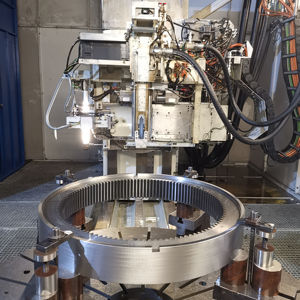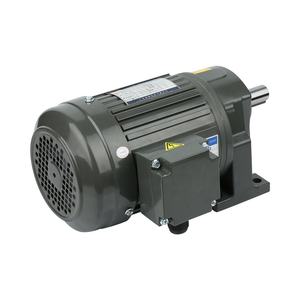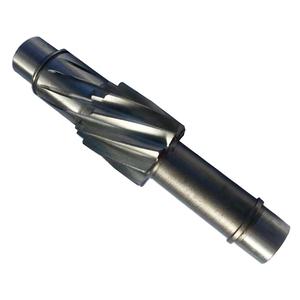PRODUCT PARAMETERS
Description
Overview of transmission gear parts
Gears are mechanical elements that are typically used to transmit rotational motion and force. They work by meshing teeth with each other to change speed, direction of torque, or to transfer power between multiple shafts. Gears are an integral part of mechanical engineering and are widely used in a variety of mechanical devices.
Advantages and features of transmission gear parts
Efficient transmission: Gears are capable of directly converting power with high efficiency and low energy loss.
Precise ratios: the desired ratio of speed and torque can be obtained by selecting gears of different sizes.
Compact: transmission gear partssystems take up less space than other forms of power transmission.
High durability: well-designed gears can operate stably for long periods of time in harsh environments.
Low noise and vibration: Modern transmission gear partsmanufacturing technology ensures smooth operation and reduces noise and vibration.
Various types: Spur, helical, and bevel gears are available depending on the application scenario.

(transmission gear parts)
Specifications of transmission gear parts
Transmission gear parts need top efficiency. They deal with challenging problems on a daily basis. High anxiety and continuous movement demand dependable products. Most equipments use solidified steel alloys. These manage hefty loads without failing. Steel composition matters significantly. Typical choices include 8620 or 4140 steel qualities. These supply good strength and use resistance.
Hardness is vital for equipment teeth. Teeth needs to stand up to pitting and abrasion. Surface area firmness frequently reaches 58-62 HRC. That’s gauged on the Rockwell C scale. The core continues to be slightly softer. This mix avoids breaking under shock. Warm treatment accomplishes this equilibrium. Carburizing or induction hardening are typical procedures.
Accurate measurements are non-negotiable. Gears need to mesh completely. Tight resistances control size and shape. AGMA or ISO standards normally specify these limits. Equipment tooth profiles call for specific geometry. Involute curves need to be precise. Reaction, the little void in between teeth, is carefully managed. Insufficient causes binding. Too much produces sound and wear.
Surface finish affects efficiency and sound. Smoother tooth surfaces decrease rubbing. Grinding or honing after warm therapy accomplishes this. Proper lubrication is vital. Oil needs to flow easily over the equipment surface areas. Harsh finishes trap oil and boost wear.
Quality checks take place at every step. Material certificates verify alloy structure. Solidity testing validates surface area and core values. Dimensional inspection makes use of precise determines. Coordinate measuring devices inspect complicated profiles. Aesthetic inspection seeks surface problems. Non-destructive testing locates surprise problems. X-ray or magnetic fragment inspection is common.

(transmission gear parts)
Applications of transmission gear parts
Transmission gear components move power inside machines. They transform speed and torque. Several sectors depend on these components on a daily basis.
Vehicles and vehicles use them heavily. Hands-on transmissions require equipments for the vehicle driver to move. Transmission additionally make use of complicated equipment sets. They shift power smoothly without vehicle driver input. Differentials make use of equipments to send out power to the wheels. They enable wheels to turn at various rates in corners. Electric cars still need equipment reducers. These components step down the motor’s high speed to useful wheel rotation.
Manufacturing facility makers depend on equipment systems. Conveyor belts make use of gears to go for the right speed. Huge presses require enormous force. Equipment reducers offer that power. Robotic arms typically make use of precision equipments. These parts enable specific motions for setting up tasks. Product packaging lines require reputable timing. Gears synchronize different parts of the procedure.
Airplane require really certain gear applications. Jet engines use gearboxes. These parts drive accessories like fuel pumps. Helicopters have a main gearbox. It moves engine power to the blades expenses. Touchdown gear systems often utilize equipments. They assist withdraw the wheels after launch.
Wind generators require big, strong gears. The rotor spins gradually. The generator needs broadband. A gearbox enhances the turning rate dramatically. This makes power production reliable. Nuclear power plant use equipments too. They control heavy steam turbine results and other hefty tools.
Agricultural equipment encounters difficult conditions. Tractors utilize gearboxes for drawing executes. Combines requirement gears to drive cutting mechanisms. Construction equipment like excavators relies upon robust equipments. They deal with the anxiety of moving planet. Mining equipment uses heavy-duty gear systems. They power drills and crushers deep underground. These components work hard in demanding atmospheres.
Campony Introduction
Established in 2002, Shift Gear Machinery Co.,ltd. focus on metal research and mining machinery spare parts. 2 factories over an area of 13,300 square meters, based on 100+ sets of equipment, our production capacity reaches 12000 Tons/Year. has passed ISO 9001 quality managment system certification in 2008.
Our mainly products are dragline excavator spare parts,rotary kiln spare parts, large modulus gear (gear shaft), gearbox ect. 40+ patents with over 45 years experience to help focus on improve the service life of spare parts. We belive that more than 80% reason of mechanical parts’ working life depends on hot processing (steel making/forging/casting/welding/heat treatment). Eight material engineers will control the quality from the original resource.
If you are interested, please feel free to contact us.
Payment
L/C, T/T, Western Union, Paypal, Credit Card etc.
Shipment
By sea, by air, by express, as customers request.
5 FAQs of transmission gear parts
Here are the top 5 FAQs about transmission gear parts:
What material are the gears made from?
Our transmission gears use hardened steel. Hardened steel offers great strength. It handles the stress inside your transmission. This material resists wearing down. It lasts longer than cheaper options. You get reliable performance.
How do I know if my transmission gears are bad?
Listen for unusual noises first. Grinding or whining sounds often mean gear trouble. Check for metal flakes in your transmission fluid too. This is a clear sign of gear wear. Your car might struggle to shift gears smoothly. Leaking fluid near the transmission could also point to internal problems. Don’t ignore these signs.
Will these gears fit my specific car model?
Always check compatibility before buying. Transmission designs vary a lot between models and years. Use your vehicle’s exact make, model, year, and engine size. Match the part number from your old gears if possible. Referencing your VIN is the safest way. We list compatible vehicles for each part.
How long should transmission gears last?
Gears should last a very long time with proper care. Think 150,000 miles or more. This depends heavily on your driving habits. Regular fluid changes are crucial. Avoid harsh shifting and heavy towing. These actions put extra strain on gears. Poor maintenance shortens gear life significantly.
Can I install new transmission gears myself?
Replacing transmission gears is a major job. It requires specialized tools and deep knowledge. You need to disassemble the entire transmission unit. Precise measurements and adjustments are necessary. Mistakes can destroy the whole transmission. We strongly recommend professional installation by a certified mechanic. It protects your investment.

(transmission gear parts)
REQUEST A QUOTE
RELATED PRODUCTS

MAR series low backlash and high precision helical gear reducer 60/90/115/142/180 low clearance stepping planetary servo gearbox

power tool gear pto shaft spline machine drive shaft high gd705a4 bevel gear

OND manufactures 26 27 28 mm height 2 6 lugs black pom gear rack and pinion lift

Pinion Spare Parts for Mini Lathe Metal Spur Gear

Aokman Solid Shaft Output Cyclo Gear Motor Cycloidal Gearbox for Power Industrial Transmission

